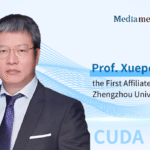
Editor’s Note: The 2025 Annual Meeting of the Chinese Urological Association (CUDA) was successfully held from June 12 to 15 in the coastal city of Zhuhai. With the theme “Healthy China, Urology First,” the event brought together medical professionals nationwide to exchange knowledge and share best practices in urologic care. In an exclusive interview with Oncology Frontier – UroStream, Professor Nianzeng Xing, President of the conference and Chair at the Cancer Hospital of the Chinese Academy of Medical Sciences, outlined China’s recent urologic innovations that contribute meaningfully to the nation’s “Healthy China” blueprint.Healthy China, Urology First
Chinese Urologists Drive Innovation and Excellence
Oncology Frontier – UroStream: Professor Xing, what do you see as the most significant developments in China’s urology field over the past year?
Prof. Nianzeng Xing: Over the past year, Chinese urologists have achieved noteworthy advances across a range of areas, including urologic oncology, urolithiasis, and benign prostatic hyperplasia (BPH).
In oncology, we’ve seen broader adoption of minimally invasive surgical technologies nationwide, particularly with rapid progress in domestic robotic systems. These platforms have become more refined and are now widely used across hospitals, greatly improving the precision and finesse of urologic surgery. Notably, Chinese surgeons were among the first in the world to perform remote surgery using domestically developed robotic systems. For example, Academician Xu Zhang successfully conducted a remote radical prostatectomy from Italy during the European Laparoscopy and Robotic Surgery Challenge. Similarly, our team at Peking University Hospital performed a remote surgery on a patient in Kazakhstan. These cases showcase the fast-evolving capabilities of both Chinese surgical technologies and clinical teams.
On the research front, we’ve also seen breakthroughs in tumor therapy. Domestically developed anti-cancer drugs—especially antibody-drug conjugates (ADCs)—have shown promising efficacy. I’m honored to have led several international multicenter clinical trials, including one evaluating a combination of a Chinese-made ADC and bispecific immunotherapy in the neoadjuvant treatment of bladder cancer. The early results are impressive, and we aim to publish and promote these findings in the academic community soon.
In the field of stone disease, we’re proud to note that minimally invasive procedures are now standard practice across China. Together with Prof. Jianxin Li, I’ve helped advance ultrasound-guided percutaneous nephrolithotomy over the past two decades. This technique, now internationally recognized, is especially suited to China’s clinical realities: ultrasound is more accessible than C-arm fluoroscopy, especially in primary hospitals, and avoids radiation exposure to both patient and surgeon. Today, this method is a mainstay in China’s stone management toolkit—an achievement we’re truly proud of.
For BPH, we’ve launched a multicenter study in collaboration with leading institutions and Prof. Maojun Yang at Tsinghua University’s School of Life Sciences, with hopes of achieving breakthroughs in the understanding and treatment of the disease. Initial results are encouraging. Meanwhile, domestically developed laser devices—such as the A ONE thulium fiber laser system I co-invented—are now widely used both in China and abroad, offering results that rival top international systems.
In kidney transplantation, we’ve also made remarkable strides. CUDA Vice President Prof. Weijun Qin and Academician Kefeng Dou recently completed Asia’s first genetically engineered pig kidney transplant, achieving over 100 days of graft survival—a historic breakthrough in xenotransplantation.
These advances highlight how Chinese urologists are not only pioneering new technologies and treatments but are also contributing meaningfully to the global urology community.
Forge Ahead with Determination, Scale New Heights Focusing on the Development and Application of Innovative Diagnostic and Therapeutic Technologies in Prostate Cancer
Oncology Frontier – UroStream: Professor Xing, you delivered a presentation on prostate cancer at this year’s CUDA conference. Could you elaborate on some of the major breakthroughs in the oncology field, especially in prostate cancer?
Prof. Nianzeng Xing: Indeed, Chinese urologists have made several noteworthy advances in oncology, particularly in prostate cancer. At this year’s conference, I presented updates on the progress of immunotherapy in prostate cancer, with a focus on cell-based therapies. Although CAR-T therapy has shown limited efficacy in solid tumors overall, our recent work with CAR-NK cell therapy has yielded promising early results. We have already initiated clinical trials, and even with a very low dose—what we refer to as a “sentinel dose,” only about one-tenth of the expected therapeutic dose—we observed a rapid decline in tumor markers. These findings are truly exciting.
We are also actively researching non-invasive diagnostic methods for prostate cancer, especially techniques that eliminate the need for biopsy. This includes approaches that do not rely solely on tissue pathology but still offer reliable diagnostic accuracy. So far, our preliminary outcomes have been quite encouraging.
Looking ahead, we hope to explore some potentially disruptive innovations. Traditionally, we’ve depended on histopathology for diagnosis, but could we instead use liquid biopsies or cytopathological techniques to detect prostate cancer, guide treatment decisions, and assess prognosis? Specifically, we aim to distinguish between clinically significant prostate cancer—requiring treatment—and clinically insignificant cases that may be safely monitored. This is a direction I find particularly exciting.
I believe these efforts will lead to transformative advancements and mark a leap forward in our field. This commitment to innovation is driven by our shared mission under the “Healthy China, Urology First” vision. I’m confident that many more research breakthroughs and clinical surprises are on the horizon.
Ultimately, our goal remains clear: to bring tangible benefits to patients and share more of China’s wisdom and solutions with the world—ensuring that patients everywhere can access the most advanced, effective treatments available.



